Poutautoko have held a wide range of workshops and activities with the community in Tokomaru in the wake of the severe weather events, as they develop ways to understand the state of their taiao, and prepare themselves for what the future may bring.
KO TE IRA E WHAKAATU ANA I TE ORANGA – eDNA
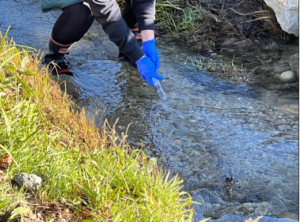
Learning essential life skills and research techniques to build resilience in the wake of severe weather events. Local people from Te Tairāwhiti taking water samples to be sent to eDNA laboratory in Wellington.
This was a project developed as a response to cyclone Gabrielle by the Environmental Protection Authority and Wai tūwhera o te taiao. It was developed to enable local people from the Tairāwhiti region to be able to take samples and prepare them to be sent away to the eDNA laboratory in Wellington. The training also considered interpreting the returned reports. All the training to date has taken place in Tūranga-nui-a-Kiwa.
Many whānau and hapū organisations from the Tairāwhiti region are involved in the project/ planning. Other organisations involved are the Gisborne District Council and forestry companies. The number of attendees throughout the whole training was 54.
The training took place in stages, both practical and theory. Practical training took place at two streams that feed into the Tūranga river. Twelve samples were taken from both sites and prepared for analysis. Participants at the training were also given two sample kits to take samples of awa in their local area.
The major learning involved was the safe and proper use of the eDNA kits, but more importantly learning about what could still be living in our awa after a major weather event. Understanding that these eDNA kits are a tool to find out what could be living in our freshwater systems, also help us make better decisions on land use around and near our rivers.
TE KURA O MATĀ
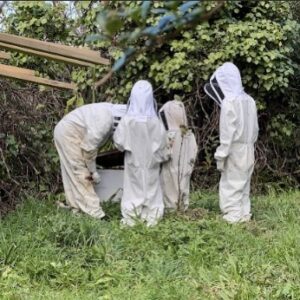
Anei ngā tamariki o te kura o Matā e tirotiro ana ki te miere me te kuini o te whare pī.
This project was run in partnership with Te Kura o Matā. It was a collaboration of time and resources to run the environmental and reo Māori programme. The Tairāwhiti Poutautoko was approached by the principal of Matā to help with incorporating environmental and te reo Māori education into their kura. Some of the learning we came up with was planting, learning how to use a compass to set up trapping lines for possums, and some sustainable living learning. This project was run weekly, either in the Tokomaru Bay area or at Te Kura o Matā, Huiarua Station. Te reo Māori was introduced throughout these learning kaupapa.
Te Kura o Matā is a very small country school with a roll of ten students ranging in age from five years old (year 1) to 11 years old (year 7). Throughout this project, parents and grandparents of the students were regularly involved in the weekly programme.
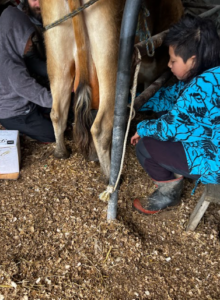
Learning how to milk a cow and process the milk.
We managed to get 12 full-day sessions with this group from July to December. There was a wide range of activities planned for this group. The activities we got to are as follows:
- learning how to use a compass to set up trap lines,
- learning how to hand-milk a cow and process the milk,
- beekeeping,
- preparing pārekereke for kūmara tipu,
- learning about different possum traps and where and how to safely set them in a home and bush setting,
- planting native trees, and
- observing and discovering life on the rocky and sandy seashore.
The learning involved in this project was based around being observant of the natural environment and thinking of how we can live more sustainably. A holistic approach was implemented to this programme based around modeling environmental awareness and sustainable living. Showing, discussing, practising and taking the time to reflect on these ideas with these tamariki was the approach to all the activities and learning.

Pārekereke preparation for kumara tipu. Pārekereke are also known as tāpapa in other rohe.

Anei ngā mahi matai o te kura o Matā. He kitenga ohorere, he kitenga miharo te kekeno nei.
PAPAMAHI UMU PIHAPIHA (PIZZA OVEN)
This papamahi was run by a participant who attended the first papamahi umu pihapiha, who wanted to incorporate it into the ‘Tiaki kāenga, tiaki tangata’ program they are developing. The Tairāwhiti Poutautoko provided advice and supported them through this papamahi.
One of the big ideas of the original project that started early March was that participants would take the skills learnt to build their own woodfired ovens. This is what took place during this papamahi where one of the participants decided to run their own pizza oven workshop. This project was run at a property in Tokomaru Bay.
Whānau from Te Araroa, Ruatōria and Tokomaru Bay were involved in this project; these people showed high interest in learning an affordable method of building a woodfired oven. These people were also keen on building and showing other people how to build a woodfired oven, passing on something they have learned to others.
There were four papamahi days set up for this project; to date two of the four days have been completed. The first was the construction of a sturdy base to build on. The following one was the mixing and pouring of a concrete slab for the oven base. There will be two more days of papamahi to complete the oven.
The learning involved in the building of a woodfired oven ranges from the safe use of hand and power tools, to working with timber and mixing cement that is fit for the construction of a woodfired oven.
A holistic approach was taken in this project which contained many layers. It has intergenerational aspects; we had a vast array of ages during this project from highschool-aged rangatahi to pakeke. As a mauroa / long term vision, this project will serve as a model of what people can do to prepare their homes and communities for hard times. During this project we also had a wānanga about how we came to doing a project like this and how the building of a woodfired oven can support whānau during times such as states of emergency.
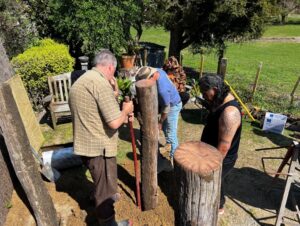
Hanga umupiha.

Te papa mō te umupiha.
URU RĀKAU
Planting day was run by Te Aho Tū Roa with support from Te Uru Rākau funding.
This project has been a continuation from the last planting season. The location of the current planting project is in Tokomaru Bay, at a 0.8-acre section of the property has been set aside for planting; another 0.4 acre has been allocated for further planting on the neighbouring property. These areas have been picked for planting because they are safe from serious flooding, as other planting projects in the district have simply been washed away.
A small number of people and organisations are involved in this project. The seedlings were purchased from two local propagators in the Tairāwhiti area: Women’s Native Tree Project Trust and Uawa Factory Road Native Nursery. Two groups were involved in this season’s plantings: Te Kura o Matā and Huiterangiora Kaitiaki; an environmental organisation from Uawa.
We planted 200 trees including kahikatea, pūriri, tawa, tōtara, karamū, tī kōuka, putaputawētā, makomako, koromiko, akeake, karaka, harakeke, karo and others.
The learning involved with the project ranged from hands-on work such as safe use of fencing tools and construction of a fence, to identifying different species of trees and the likely position in a landscape that could suit their growth.
The holistic learning approach has intergenerational aspects, where tamariki and other participants are beginning to realise that we may not see the true benefits of this mahi but know that one day it will help support birds, insects and people in future.
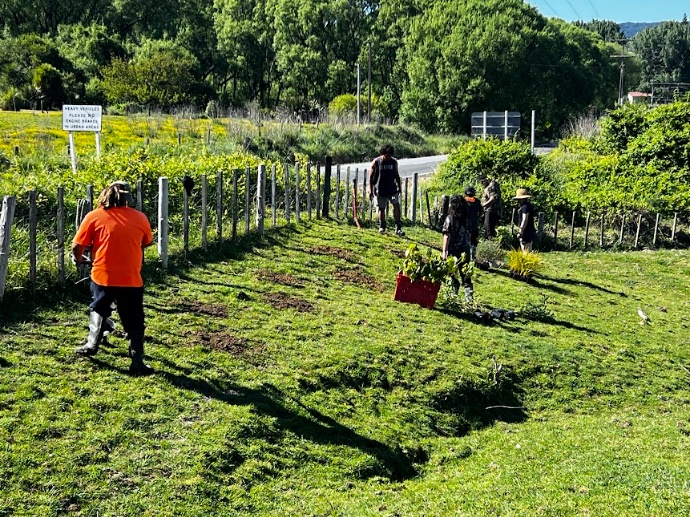
Whānau from Te Tairāwhiti preparing the whenua for planting natives which were sourced from two local propagators – Womens Native Tree Project and Trust and Uawa Factory Road Native Nursery.
ARAHANGA TAIAO

Arahanga Taiao members during one of their regular meet ups to discuss, investigate and monitor environmental impacts since Cyclone Gabrielle.
This rōpū came about after Cyclone Gabrielle. It was seen that the Tokomaru Bay area is in need of a rōpū that investigates and monitors the environmental state of the area. The rōpū Arahanga Taiao is made up of three whānau living in and near Tokomaru Bay.
The initial project was to develop an entity, gain financial support and come up with some plans to reconnect, discover and monitor our taiao that we live in. May groups involved in supporting the development of Arahanga Taiao are the Tairāwhiti District Council, Te Mauri Tau, Ministry of Business, Innovation and Employment and Manaaki te Awanui.
Between July and December, we have had 11 hui/ wānanga to establish Arahanga Taiao, and to gain funding and support from other groups.
At this stage the learning involved for this rōpū was around the development of an entity and the tikanga that the rōpū want to follow while they work together. Applying for major funding through applications and proposals was also a learning.
The bringing together of skillsets to this rōpū gives a broad view on the kaupapa ahead. The rōpū consists of administrators, educators, marine scientists, forestry managers and all types of environmental work backgrounds.
The last six months have been challenging and exciting, full of wins for the whaitua. I feel with the way our climate is going and the current state of our taiao, the skills within the projects above will be relevant and a necessity in the months and years to come. I truly look forward to what is ahead. There is still a very long and rocky track ahead of us, but we are heading in the right direction with goals and ideas.
Ka tika rā me horo āku mihi ki te whānau o Te Aho Tū Roa, Toimata me ngā tini whānau o te whaitua o te Tairāwhiti i whai pānga ki ngā mahi kua tutuki i ngā marama kua hipa. Mei kore ake mō koutou katoa e kore rawa au e whai oranga pēnei. Tēnā rā koutou katoa.
– Karauria Ratapu, Poutautoko Tairawhiti





